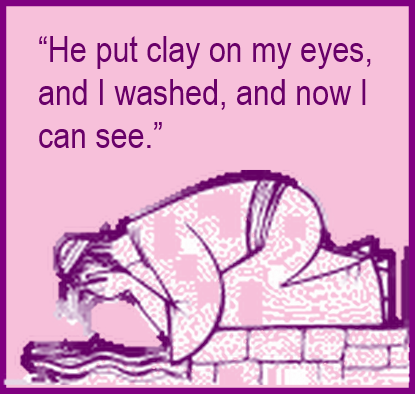Readings: 1 Samuel 16:1,6-7,10-13; Ephesians 5:8-14; John 9:1-41
Theme: ‘Be like children of Light’ (Eph 5:8)
Last Sunday we had wonderful story from the Gospel of John, featuring a Samaritan woman who meets Jesus at Jacob’s well and ends up becoming a missionary to her town’s people. Today we have another equally fascinating story, also from John’s gospel. This time the story features a man, a blind beggar, who is cured by Jesus and becomes his disciple, courageously standing up to the Pharisees who refuse to believe in him.
During World War II the American journalist and champion of racial equality, John Howard Griffin, was blinded in an air-plane explosion, and for twelve years couldn’t see. Then one day, as he was walking down a street near his parents’ home in Texas, he began to see ‘red sand’ in front of his eyes. Almost immediately, his sight was restored. The eye specialist explained to him the reason for the extraordinary recovery of his sigh. A blockage of blood on the optic nerve, caused by the explosion, had opened, giving him back his sight. Later, in an interview with a newspaper reporter, Griffin said: ‘You don’t know what it means for a father to see his children for the first time. They were much more beautiful than I ever suspected’. Griffin’s dramatic experience may give us some inkling of the joy felt by the hero of today’s gospel when he was able to see for the first time.
The physical cure of the blind man, wonderful as it is, is not the main focus of our gospel reading. It is just a prelude to the more awesome miracle of spiritual sight, of the blind man’s awakening to faith in Jesus. This miracle of faith happens gradually, mirroring the physical cure, which was also gradual. Initially, when some people question him about his cure, he simply recounts what happened to him, stating that ‘the man called Jesus’ (Jn 9:15) was responsible for his cure. Later in the story, under interrogation by the Pharisees, our hero courageously stands up to them and declares that Jesus ‘is a prophet’ (cf. Jn 9: 17). Finally, when he meets Jesus again, John tells us that he professes his belief in him as ‘the Son of Man’ (Jn 9:35) and worships him.
It is no coincidence that the cure of the blind man and his profession of faith in Jesus coincided with one of the major Jewish feasts, the Feast of Tabernacles. During the time of Christ, this feast had come to be known as simply ‘The Feast’ . It lasted seven days and, on every night during this feast, four great lights were lit in the Temple of Jerusalem, illuminating the entire temple precinct. This ceremony was intended to remind the people of the pillar of fire, symbolising the presence of God, that had led them during their journey in the wilderness of Sinai. This ceremony was also a reminder that God had promised to send another greater light to renew Israel’s glory, release the people from bondage, and restore their joy. It is in this context that Jesus’ cures the man born blind and declares himself to be ‘’the light of the world’ (cf. Jn 9: 10). By this statement, Jesus is implying that he is not just a prophet, but also the light of God – the same light that led them through the wilderness of Sinai. He is the very real presence of God among them.
The blind man’s faith journey and acceptance of the light of Christ clearly echoes the spiritual awakening of the Samaritan woman whom we met in last Sunday’s gospel. It also stands in stark contrast to the spiritual blindness of the Pharisees who obstinately refuse to accept the man’s testimony to Jesus, dismissing him as a sinner and driving him away (cf. Jn 9:34). Their arrogance and conviction that, with Moses as their guide, they are already living in the light, leads them to reject the very light to which Moses had born witness (cf. Jn 5:47). Jesus underlines the sad irony of an unschooled blind man awakening to the light of Christ while the Pharisees, schooled in the Mosaic Law, remain enclosed in darkness. He states: ‘It is for judgement that I have come into this world, so that those without sight may see and those with sight turn blind’ (Jn 9: 39).
As disciples of Jesus, we are invited, to learn from the example of the blind man in today’s gospel, and open our hearts fully to the light of Christ. Then, as St Paul reminds us in our second reading, we must continue to live ‘like children of light… in complete goodness and right living and truth’ (Eph 5:8), rolling back the darkness of our world until it is filled with the presence of the God who is Light.
I will end with a reflection on the gift of light from the pen of Sean Goan:
It is a reasonable thing to be afraid of the dark:
the obstacles in our path might be anywhere, everywhere.
And yet with time we can probably manage it.
We get used to fumbling around and we persuade ourselves
that maybe this is how it was meant to be;
we can settle for the shadows.
Then the dawn comes and slowly we learn to see…
it is so much more beautiful than we could ever have imagined.
Light gives colour, shades, perspective, new horizons.
Everything is different and the gift that is offered
is to contemplate Life in all its wonder.
Do not be afraid, just come and see the God who is Light,
in whom there is no darkness at all.’
Michael McCabe SMA
To listen to an alternative Homily for this Sunday, from Fr Tom Casey of the SMA Media Centre, Ndola, Zambia please click on the play button below.
|
|

